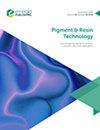Optimization and analysis of dry sliding wear process parameters on cellulose reinforced ABS polymer composite material
IF 1.5
4区 材料科学
Q3 CHEMISTRY, APPLIED
引用次数: 0
Abstract
Purpose This study aims to the optimization using three factors and three-level parameters (sliding speed [rpm], sliding distance [m/s] and load [N]) of design matrix were adapted to Box–Behnken design using design expert v8.0 software. Based on the parameters, to develop the linear regression equation and to find the significant considerable wear process parameters based on output responses like wear loss (WL) and coefficient of friction (COF) value of polymer matrix composites (PMC) specimen of Acrylonitrile-butadiene-styrene (ABS)/cellulose composite (80 wt% of ABS and 20 wt% of cellulose). Design/methodology/approach The fabrication of the ABS/cellulose composite sample was carried out by the simple hands-on stir process method. As per the American Society for Testing and Materials G99 standard, the sample was made by the molding process. The wear analysis was made by multi tribotester TR25 machine and validated the developed model by using statistical software design expert v.8.0 and numerical tools like analysis of variance. The surface morphology [field emission scanning electron microscopy (FESEM) analysis] of the sample was also observed using the Quanta FEG-250 FESEM instrument. Findings The parameters like sliding speed, sliding distance and load are independently affected the COF value and WL of the 80% of ABS matrix and 20% cellulose reinforced composite material. The regression equations were generated by the coefficient of friction value and WL, which predicted the minimum WL of 80% of ABS matrix and 20% of cellulose reinforced composite material. The worn surface analysis result exposes the worn path and equal distribution of reinforcement and matrix on the surface of composite material. Originality/value The literature survey revealed a small number of studies available regarding wear analysis of ABS matrix and cellulose reinforced composite materials. In the present work, to fabricate and evaluate the wear performance of PMC (80% of ABS and 20% of cellulose) depends on the WL and COF value. The maximum and minimum COF value (µ) of 80% of ABS and 20% of cellulose composite material is 4.71 and 0.28 with the optimized wear process parameter by 1,000 mm of sliding distance, 0.25 (m/s) of sliding speed and 9 N of load.纤维素增强ABS聚合物复合材料干滑动磨损工艺参数优化分析
目的本研究旨在使用三因素进行优化,设计矩阵的三级参数(滑动速度[rpm]、滑动距离[m/s]和载荷[N])使用设计专家v8.0软件适用于Box–Behnken设计。基于这些参数,建立线性回归方程,并根据输出响应,如丙烯腈-丁二烯-苯乙烯(ABS)/纤维素复合材料(80 ABS的wt%和20 纤维素的wt%)。设计/方法/方法ABS/纤维素复合材料样品的制备通过简单的动手搅拌工艺方法进行。根据美国测试与材料协会G99标准,样品通过成型工艺制成。使用TR25多摩擦试验机进行磨损分析,并使用统计软件设计专家v.8.0和方差分析等数值工具对所开发的模型进行验证。还使用Quanta FEG-250 FESEM仪器观察样品的表面形态[场发射扫描电子显微镜(FESEM)分析]。结果:80%的ABS基体和20%的纤维素增强复合材料的COF值和WL与滑动速度、滑动距离和载荷等参数无关。由摩擦系数值和WL生成回归方程,预测了80%的ABS基体和20%的纤维素增强复合材料的最小WL。磨损表面分析结果揭示了复合材料表面强化层和基体的磨损路径和均匀分布。原创性/价值文献调查显示,有少量关于ABS基体和纤维素增强复合材料磨损分析的研究。在本工作中,制备和评估PMC(80%的ABS和20%的纤维素)的磨损性能取决于WL和COF值。80%的ABS和20%的纤维素复合材料的最大和最小COF值(µ)分别为4.71和0.28,优化的磨损工艺参数为1000 mm的滑动距离,0.25(m/s)的滑动速度和9 负载的N。
本文章由计算机程序翻译,如有差异,请以英文原文为准。
求助全文
约1分钟内获得全文
求助全文
来源期刊

Pigment & Resin Technology
工程技术-材料科学:膜
CiteScore
2.80
自引率
21.40%
发文量
91
审稿时长
>12 weeks
期刊介绍:
The journal looks at developments in: ■Adhesives and sealants ■Curing and coatings ■Wood coatings and preservatives ■Environmentally compliant coating systems and pigments ■Inks for food packaging ■Manufacturing machinery - reactors, mills mixing and dispersing equipment, pumps ■Packaging, labeling and storage ■Plus topical features and news on materials, coatings, industry people, conferences, books and so on ■Raw materials such as pigments, solvents, resins and chemicals ■Testing equipment and procedures
 求助内容:
求助内容: 应助结果提醒方式:
应助结果提醒方式:


